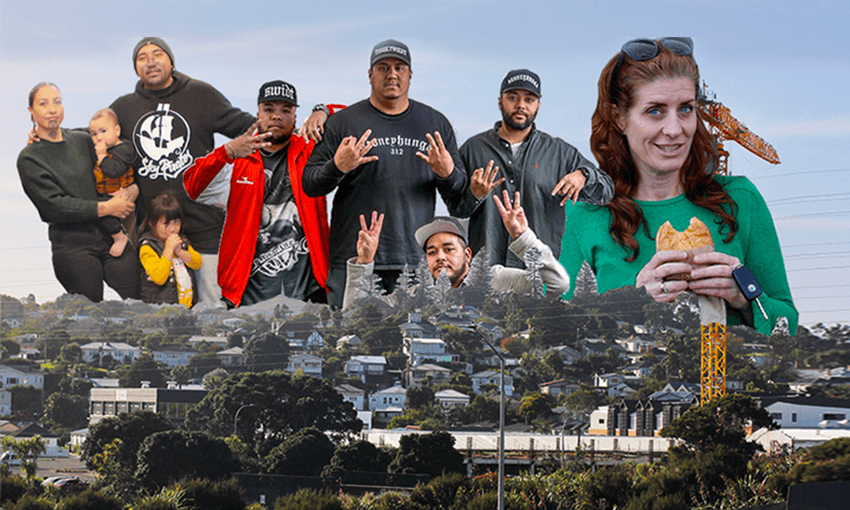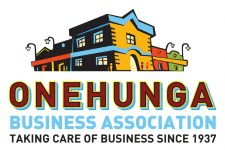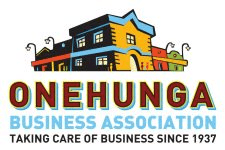Onehunga is one of the most eccentric suburbs in the supercity. Josie Adams got a tour of the beating heart of Auckland from its inventive locals.
Onehunga sits at the very centre of Auckland, nestled between Mangere and Cornwall Park. Major transport arteries flow through and around the suburb connecting east to west and north to south. Visit for the day and you’ll find a joyful community that represents every part of Auckland. The streets are full of humble history, colour, and eccentric locals. There’s growth and development coming – and it’s been welcomed as an opportunity. All at once, Onehunga is artsy, grimy, and family-friendly.
My first guide is Francesca Rudkin, Newstalk ZB host and film critic. She has an air of being permanently rushed off her feet and happy about it. Her house, an art-deco design with a steeply-sloping but lemon-heavy backyard, is on one of Onehunga’s heritage streets. She’s been here for 12 years. She and her husband moved to the suburb when they started a family, and can’t imagine raising their two kids anywhere else in Auckland. Their kids get to grow up surrounded by what Francesca sees as a valuable community. “I think living here will keep them grounded,” she says. “It’s all rugged. It’s real. That’s the best thing about it.”
Only five minutes from her house is the waterfront. I didn’t think of Onehunga as coastal, but it was only cut off from the ocean by the South Western motorway in 1977. Four years ago the council gave Onehunga back its beach when it built a bridge over the motorway and turned the land into a park called Taumanu (‘reclamation’). Here, the suburb’s natural and urban environments happily collide. New Zealand’s first cable-towed wakeboarding park pulls riders over jumps and rails in the middle of a man-made lake. Dogs chase balls in its shallows. Children ride bikes, scooters and skateboards on the halfpipe. This organised chaos is a perfect representation of the suburb she loves.
Standing on the bridge, the Manukau harbour on one side and the cranes of development on the other, Francesca points out three religious spires – one Anglican, one Catholic, one Hindu – that point up between powerlines, cellphone towers and rising apartment blocks. Over the bridge, artfully man-made beaches wind along to a running trail, which works its way along the coast and through native bush and wildlife all the way to New Lynn. It’s all of Auckland in one scene: harbour, bush, and industry.
At Jellicoe Park, with its rows of towering palm trees, Francesca takes us on a history lesson. Opened in 1923, before it became a public park it was home to Onehunga’s most revered colonists: the Fencibles. The Fencibles were retired British soldiers sent to Auckland as a protection force for the new settlers in the 1840s. They were given a cottage and some land, which after seven years of service they would own. There are still some 90-year old residents with neighbourhood streets named after their dads.
On the park’s grassy banks we admired the replica of a Fencible cottage, an original military blockhouse, and the original 1856 manse for the Congregational church. Visit on the first and third Sunday of each month and you can explore the inside of the buildings.
The lineage of Onehunga is intertwined with war. Onehunga sent hundreds of its residents to both wars, resulting in a massive archway in memory of them, and a list of those who lost their lives engraved on the side of the public swimming pool. The Onehunga war memorial swimming pool is free for kids and just a few coins for adults. Its high diving board has been a constant in the lives of local children since 1956.
We come out on to the famous Onehunga Mall through the cemetery at St. Peter’s Anglican church. We hunted out the plaque of Elizabeth Yates, who, when she took the mayoralty of Onehunga in 1893, became the first female mayor in the British Empire. Next week a mural of Yates is being painted on the corner of the Mall and Pearce St, as part of the Onehunga Arts Festival. Come and watch it take shape.
Francesca takes us for a wander from the church to Penny Lane’s Bakery – a favourite of local hip hop heroes SWIDT. It’s just a few blocks down Onehunga Mall, past the first iconic original Look Sharp and, the bright clothing of Tav Pacific.
Francesca comes to Penny Lane’s for the slices and retro lolly cakes that remind her of visiting her grandmother. SWIDT comes to Penny Lane’s for the award-winning pies. A crisp and flaky pastry, a smooth filling, a trail of crumbs down the main strip; that’s a good pie.
Back down the hill and onto a side street, Francesca points out The Fade Joint, a barber that’s become a focal point of the community with its pool table and slick fades. “It’s very cool,” she says as we peer in the windows. A friendly dig at her husband’s age, Francesca notes that he is probably too old for a dope fade, and shows us his friendly barber on the main street: Brother Haircut.
To an outsider, it looks like Onehunga’s soul hangs in the balance. $140 million has been dedicated to developing the suburb over a decade, and we are already three years in. The growth is being managed by Panuku Development Auckland. Coming in the next few years is housing for thousands of new residents, improved transport networks, and the continued development of the natural environment.
I ask Francesca if she felt the origins and heart of Onehunga would change with the proposed new developments. She’s sure nothing will change. “Onehunga is diverse in every way: economically, ethnically, socially,” she leans over the car and holds my gaze. “Onehunga’s soul will never die.”
In fact, it feels like it’s growing. Before my second tour, I start with a caffeine hit on the main strip. Mr T’s, a coffee shop, bakery, and Vietnamese restaurant all in one, is part of Onehunga’s evolving series of stores. The coffee is dark and the room is filled with the smell of Dieu Tran’s (Mr T himself) baking. The authentic phở is the perfect way to warm up on a winter’s day.
Hidden off the main street is the neighbourhood’s own coffee roastery, Dear Deer. For something stronger, the cocktails at The Bramble are famously good. In the centre of town is The Good Home, a family-friendly gastropub filling the beautiful old library. It’s equipped with a small playground for the kids and dogs are welcome.
Across the road from Mr T’s and next to Brother Haircut is Native Studios, a tattoo parlour that specialises in tā moko. One of the artists and owners, Tyler Jade, nods up at the apartments across the road above the ground floor shops. “Those are all empty. Landlords put the rent up on a lot of main street property, but no-one’s moved in.”
While we’re chatting, there’s a knock at the door. The guy who runs the sushi store up the road has come bearing plates laden with all the vegetarian sushi a family could want. All porcelain, no plastic. “Yeah, he’s just down the road,” explains Heeds. “So he brings them to us.”
This close-knit community is something hard to find elsewhere in Auckland. “Here we have rich and poor, white and brown, all religions, and no problems,” says Tyler Jade. “My kids call the Indian couple next door Nana and Koro.”
Anywhere else in Auckland, the prospect of new intensive housing and an influx of new residents would upset the locals. Not here. Everyone’s happy to accommodate a few extra folks. “We’d like more people to move in,” says Heeds.
“There’s a strong spiritual history here,” says the family, referring to not just the many places of worship dotted around Onehunga but also the suburb’s past: “Onehunga” itself means “burial place,” referring to the Māori burial caves that were once used. Heeds and Jade point out the latest in the spiritual economy: a local shaman, who lives above a money lender. Their other neighbour is Petra Zaleski, the vicar at St Peter’s Anglican church famed for her Dr Martens and tattoos.
“Have you seen the swimming pool?” Heeds asks, urgently. It’s very important. “You should see their diving board. I loved that as a kid.” I can imagine Francesca’s daughter lining up to bomb off the high board next to Heeds’ daughter, Tui.
The war memorial swimming pool is popular with the kids at The 312 Hub, too. Behind the main road and across from Dress-Smart is a creative workshop, run for youth by youth. Kian Sinapati is showing us around. He’s 18 years old and a member of The Table, a group of young local leaders who organise art education programmes, music events, and more for the youth in the area.
“The Hub is a safe space,” he says. “We have some kids coming here who are going through a lot at home. This is something positive for them to do.” When Kian joined The Hub only a year ago he found that putting in some creative hours gave him a purpose in life. “It’s amazing to see other kids come here and find their purpose, too.”
With community activities for youth being taken away or monetised – basketball courts turned into parking, street art becoming commodified – places like The 312 Hub are more important than ever. Kian might be young, but he’s run art programmes for toddlers and will be performing at the launch event of the Onehunga Arts Festival later this month. “It’s pretty amazing what we can pull off,” he confesses. This is the closest he’ll come to admitting how much he’s achieved.
The members of The Table are young, but they’ve already achieved a huge amount in a short time. Irihana Katene is only 15, but she takes her responsibilities seriously. “I’m a voice for kids who don’t have one,” she says. She and Kian are advocates, spending time talking to Panuku, the council, and various boards to communicate what kids need – and not just those in Onehunga. All through our chat kids of all ages have been coming through the hub, picking up paintbrushes, grabbing guitars. Many of them come from surrounding suburbs – Mangere, Three Kings, Otahuhu. Later tonight, several of them will fly to Wellington to pitch to Creative New Zealand.
The 312 Hub is a vibrant, welcoming, and growing space. “You don’t have to be creative,” says Kian. “You just have to have some hustle in you. We’re all hustlers.” A year nine in a bucket hat behind him nods eagerly. A sticker on the window tells us this place is good vibes only.
That’s the key. Panuku, The 312 Hub, and locals like Francesca are working to keep Onehunga’s good vibes strong throughout this redevelopment. Gentrification is a touchy subject for all, but Onehunga wants and might even need more residents. It just doesn’t want the price tag that comes with it. The essence of Onehunga – art, family, music, a swimming pool – costs less than the rent on the apartments on the main strip.
Visit Onehunga and you’ll see Auckland evolving in real time. Grab a pie, a cocktail, a fade, and meet the local businesses and residents who are retaining the suburb’s unique vibe while the city grows from the suburb’s fertile soil.
This content was created in paid partnership with the Onehunga Business Association. Learn more about our partnerships here.


